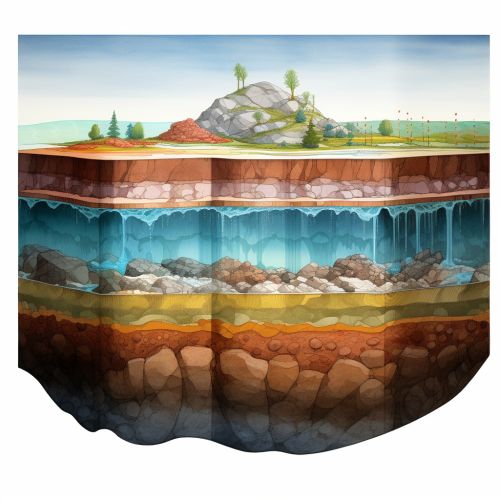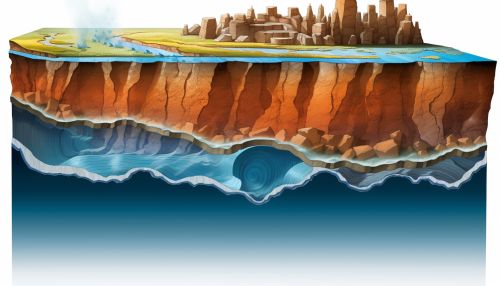Aquifer
Overview
An aquifer is a body of permeable rock which can contain or transmit groundwater. This geological structure plays a crucial role in the hydrological cycle, supplying large volumes of water to wells and springs. Aquifers are typically found in layers of gravel, sandstone, or fractured rock formations, where water can easily move through the porous material.


Types of Aquifers
Aquifers are classified into two main types: confined and unconfined.
Unconfined Aquifers
An unconfined aquifer, also known as a water table or phreatic aquifer, is located directly below the ground surface. The water in these aquifers is under atmospheric pressure, and its upper surface is known as the water table. Unconfined aquifers are recharged by rain or snow melt that infiltrates directly into the aquifer from the ground surface.
Confined Aquifers
A confined aquifer, also known as an artesian or pressure aquifer, is overlain by a relatively impermeable layer of rock or sediment known as an aquitard or aquiclude. This layer prevents water from seeping into the aquifer from the ground surface directly above. Instead, water enters a confined aquifer through areas where the aquitard is absent, such as in recharge zones.
Aquifer Properties
The properties of an aquifer can influence the movement of groundwater and the amount of water that can be extracted. These properties include porosity, permeability, and storativity.
Porosity
Porosity is the measure of the void spaces within a rock or sediment. It is expressed as a percentage of the total volume of the rock. High porosity indicates a greater capacity to store water.
Permeability
Permeability refers to the ability of a rock or sediment to transmit water. It is determined by the size and interconnectedness of the pore spaces. High permeability indicates that water can move easily through the rock.
Storativity
Storativity is the volume of water that an aquifer releases from or takes into storage per unit surface area per unit change in head. It is a dimensionless quantity.
Aquifer Recharge and Discharge
Aquifers are recharged by the infiltration of water from precipitation, rivers, and lakes. The rate of recharge can be influenced by factors such as climate, vegetation, soil type, and the permeability of the overlying rock or sediment.
Aquifer discharge occurs naturally at springs and seeps, and can also occur artificially through wells and pumps. The balance between recharge and discharge determines the water level in an aquifer.
Importance of Aquifers
Aquifers are a vital source of freshwater. They provide drinking water for people and irrigation water for crops. Aquifers also contribute to the flow of rivers and streams, especially during periods of low rainfall. In addition, they play a key role in maintaining wetland ecosystems.
Threats to Aquifers
Aquifers face several threats, including over-extraction, pollution, and climate change.
Over-extraction
Over-extraction, or over-pumping, occurs when water is removed from an aquifer faster than it can be replenished. This can lead to a drop in the water table, reduced water pressure, and land subsidence.
Pollution
Pollution can contaminate aquifers, making the water unsafe for human consumption and damaging ecosystems. Common sources of pollution include agricultural runoff, industrial waste, and improperly disposed household chemicals.
Climate Change
Climate change can affect aquifers by altering precipitation patterns and increasing evaporation rates. This can reduce aquifer recharge and lead to water shortages.
